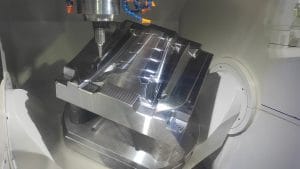CNC Machining: How To Machine Metal Parts With A Computer

CNC machining is a process of cutting metal parts with a computer. It’s a subtractive manufacturing process, which means that the computer removes material from the workpiece to create the desired shape. CNC machining is an efficient way to produce metal parts with a high degree of accuracy. The process is also relatively fast, making it ideal for prototyping and small-batch production. In this article, we will discuss the basics of CNC machining and how it works. We will also provide some tips on how to get started with CNC machining so that you can produce your own metal parts at home or in your workshop.
What is CNC machining?
Computer numerical control (CNC) machining is a process in which computer-controlled tools are used to remove material from a workpiece to create the desired shape or finish. The process can be used to machine parts from a variety of materials, including metals, plastics, and composites.
CNC machining is a versatile manufacturing process that can be used to create parts with complex shapes and features. The process is especially well suited for the production of high-precision parts, as it can produce very accurate results. Additionally, CNC machining is relatively fast and efficient, making it an ideal choice for high-volume production runs.
How does CNC machining work?
CNC machining is a computer-controlled process used to cut and shape metals. The process starts with a piece of metal, called the workpiece, which is attached to a table. A cutting tool, controlled by a computer, is then used to remove metal from the workpiece to create the desired shape.
The cutting tool can be anything from a simple drill bit to a complex end mill. The type of tool used will depend on the material being machined and the desired final product. CNC machining can be used to create both simple and complex shapes.
The computer controls the cutting tool according to instructions programmed into it. These instructions are known as G-codes. G-codes tell the machine where to move the cutting tool, how fast to move it, and what kind of cuts to make.
CNC machining is a highly accurate process that can produce parts with tight tolerances. It is also relatively fast and can be used to produce large quantities of parts.
The benefits of CNC machining
CNC machining is a process that uses computer-controlled machines to remove material from a workpiece to create the desired shape or finish. The benefits of CNC machining include increased accuracy, repeatability, and speed when compared to traditional methods such as manual machining.
In addition, CNC machining can be used to create complex shapes that would be difficult or impossible to create with manual methods. Additionally, the use of computers in the CNC machining process allows for greater flexibility in design and the ability to make changes quickly and easily. Finally, CNC machines can operate 24 hours a day, 7 days a week, which can lead to increased productivity and efficiency.
The drawbacks of CNC machining
CNC machining is a popular method for manufacturing metal parts. However, there are some drawbacks to using this technology.
One of the main drawbacks of CNC machining is the high cost of the equipment. CNC machines can be expensive to purchase and maintain. If a business does not have the budget to invest in this type of machinery, it may not be able to produce parts using this method.
Another drawback of CNC machining is the time it takes to set up and operate the machines. This process can be time-consuming, which can increase the overall cost of production. In addition, CNC machines require skilled operators. If a business does not have trained staff, it may need to outsource this work, which can also add to the cost.
Finally, CNC machining can produce parts with tight tolerances. This can be beneficial for some applications but it can also lead to problems if the part does not meet specifications. Parts that are too small or have too much tolerance can cause issues during assembly or function properly.
How to choose the right CNC machine
If you’re looking to get into CNC machining, there are a few things you need to keep in mind in order to choose the right machine for you.
First, consider what types of materials you’ll be working with. Different machines are better suited for different materials. For example, if you’re mostly going to be working with softer metals like aluminum, a milling machine might be a good choice. But if you’re planning on working with harder metals like steel, you’ll need a heavier-duty machine like a lathe.
Second, think about what kind of accuracy and tolerance you need. The more accurate and precise your requirements, the more expensive the machine will be. But it’s important to get a machine that can meet your tolerance requirements, otherwise, you risk losing money on faulty parts.
Third, consider the volume of production. If you’re only making a few parts here and there, a small desktop CNC machine might suffice. But if you’re looking to produce large quantities of parts, you’ll need an industrial-grade machine that can handle high-volume production.
Finally, make sure to factor in the cost of the machine itself as well as any associated costs like software, tooling, and shipping. Once you have all of these factors considered, you’ll be in a much better position to choose the right CNC machine for your needs.
Conclusion
CNC machining is a great way to produce metal parts with a high degree of accuracy. By using a computer to control the machine, you can create parts that are precise and consistent. If you’re looking for a way to machine metal parts, CNC machining is definitely worth considering.


